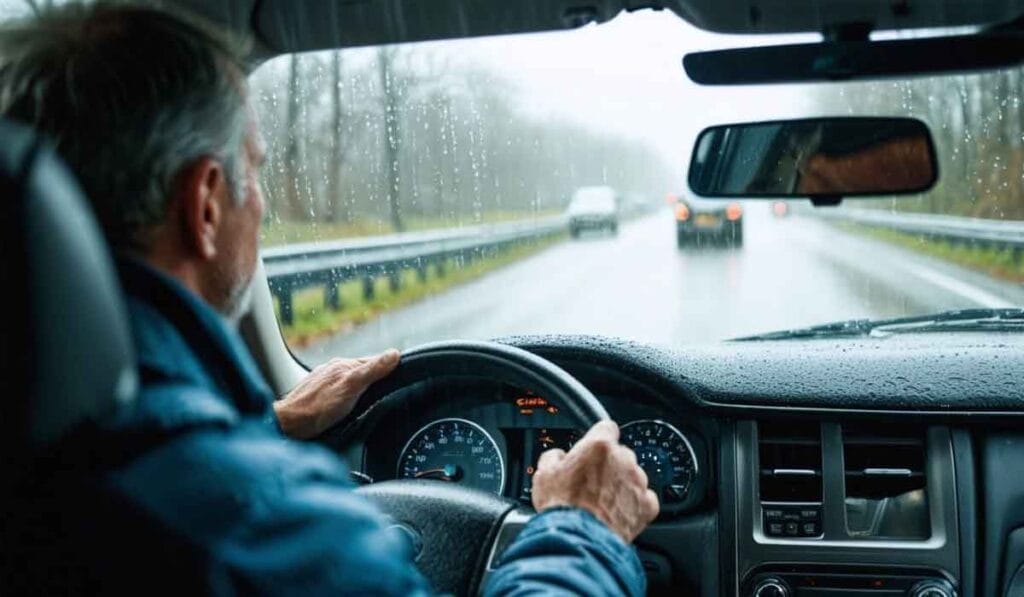The Ultimate Guide to Mastering Defensive Driving Techniques
You worry about car crashes.
Every year, lots of people get hurt in them.
This guide will show you how to use defensive driving to stay safe on the road.
Please note: We are accident doctors who charge you $0 out of pocket for the best after car accident medical care.
You should come in and get treated by us first, and then let us refer you to the best auto accident attorneys in Phoenix or Mesa.
Key Takeaways
Core Safety Principles
- Maintain a minimum three-second following distance in good conditions.
- Stay constantly aware of surroundings and potential hazards.
- Use turn signals consistently for all lane changes and turns.
- Obey posted speed limits and adjust for conditions.
- Wear seatbelts at all times.
Essential Techniques
Space Management:
- Keep safe distances from other vehicles.
- Watch for blind spots before changing lanes.
- Leave room for emergency maneuvers.
Hazard Recognition:
- Scan surroundings continuously.
- Anticipate potential dangers.
- Monitor other drivers’ behaviors.
- Watch for aggressive drivers.
Weather Adaptations
- Increase following distance in wet conditions.
- Use low beam headlights in fog.
- Reduce speed in adverse weather.
- Apply chains when needed in snow/ice.
- Adjust driving style for strong winds.
Risk Reduction Strategies
- Avoid distractions like mobile phones.
- Never drive under the influence.
- Take regular breaks during long trips.
- Practice patience with aggressive drivers/.
- Maintain vehicle safety features and lights.
Benefits
- Reduced accident risks.
- Lower insurance costs.
- Improved road awareness.
- Better reaction times to hazards.
- Enhanced overall driving confidence.
Core Principles of Defensive Driving
Defensive driving keeps you and others safe on the road. It’s all about being prepared and staying focused.
Maintain a Safe Following Distance

Maintaining a safe following distance is crucial for preventing car accidents. It gives you enough time to react if the car in front of you stops suddenly.
Traffic safety experts agree that the ideal space between vehicles is at least three seconds under good conditions.
This gap should increase with speed and in adverse weather conditions, such as rain or fog.
Making sure there’s ample room between your vehicle and others helps avoid rear-ending incidents, which are common on busy roads.
Always leave enough space to stop safely.
To determine a safe distance from the car ahead, find a fixed point on the road, like a signpost or traffic light.
When the rear bumper of the vehicle in front passes it, start counting seconds until your car reaches the same point.
If you reach it before you can count to three, slow down and adjust your following distance accordingly.
This simple technique ensures you have sufficient reaction time and contributes significantly to road safety by reducing vehicular accidents.
Driving requires full attention—avoid distractions such as mobile phones or electronic communications devices while behind the wheel.
Staying alert allows you to monitor traffic around you better and keep a safe distance from other motorists at all times.
By practicing this defensive driving principle diligently, not only do you safeguard yourself but also enhance overall safety for everyone on the road.
Stay Aware of Your Surroundings

Keeping an eye on your surroundings is a cornerstone of safe driving.
This means watching for other cars, pedestrians, and any possible hazards that could arise.
Always check your mirrors to know what’s happening around you.
Spotting aggressive drivers early can help you avoid potential accidents.
Awareness also includes paying attention to traffic lights and stop signs to ensure you’re following the rules of the road.
You must also beware of blind spots before changing lanes or turning. Use your turn signals every time you plan to move left or right.
This not only keeps you safe but also communicates your intentions to other drivers, reducing the chances of collisions from misunderstandings on the road.
Understanding when conditions are too dangerous for driving—like during heavy rainstorms or if you’re feeling fatigued—is crucial as well.
If visibility is low or if you’re not feeling alert, it’s wise to pull over safely or postpone your trip if possible.
Defensive driving isn’t just about reacting; it’s about anticipating situations before they occur and being prepared with an emergency plan should anything go wrong.
Use Turn Signals and Obey Speed Limits

Always use your signal-light before you turn or change lanes. This simple act lets other drivers know your plans.
When you share the road, clear communication is key to preventing traffic accidents and ensuring safety for everyone, including pedestrians who rely on signals to understand vehicle movements.
Following speed limits is crucial for safe driving. These rules are set based on the layout of roads, traffic flow, and areas where pedestrians are present.
Speeding increases the chance of losing control of your vehicle and reduces reaction time in avoiding a collision.
Stick to the speed limit to protect yourself and others from potential car collisions and legal consequences such as fines or points against your driving record.
Remember, being a few minutes late is better than risking an accident.
Benefits of Defensive Driving

Mastering defensive driving can turn the roads into a safer place for everyone.
Embracing these skills helps you avoid hazards and reduce your risk of getting into crashes.
First, by keeping a safe gap from the car in front, you’re less likely to crash if they stop suddenly.
This practice gives you more time to react. Second, being alert means you see problems before they happen.
You can dodge dangers that catch other drivers off guard.
Signals are key too. They let others know your moves ahead of time, preventing surprises.
Also, sticking to speed rules keeps everyone at a predictable pace — making it easier for all to coexist on the road safely.
The payoffs?
Fewer mishaps mean fewer visits from law enforcers or trips to courtrooms discussing damage with personal injury attorneys.
Your vigilance cuts down the chance of tough talks with insurance companies about damages or injuries after an incident.
Driving defensively also sharpens your skills behind the wheel. It makes you more aware of how.
Reduced Accident Risks

Defensive driving lowers your chances of getting into road accidents.
Learning to keep a safe distance from the car ahead and staying alert helps you react quickly to sudden stops or hazards.
This means fewer fender-benders and reduced risks of more serious crashes, like head-on collisions.
Wearing your seat belt, obeying traffic laws, and avoiding distractions—such as cell phones—play huge roles in keeping you safe.
Following these practices not only keeps you out of harm’s way but also protects other drivers and pedestrians sharing the road.
Defensive driving courses stress the importance of anticipating potential dangers, understanding how distracted driving or driving under the influence can lead to tragic outcomes.
These courses often use real-life examples to show how maintaining awareness and making smart choices significantly decrease accident risks.
Safe driving is no accident. It’s a conscious decision to drive in a way that anticipates and reacts correctly to all possible scenarios on the road.
Increased Driver Awareness
Driving safely means keeping your eyes wide open and staying alert.
You need to spot dangers before they turn into problems.
This requires knowing what’s happening all around you, not just in front of you.
Imagine driving while drowsy or looking at your phone.
Suddenly, stopping for a red light becomes a major challenge.
Your brain doesn’t get the message fast enough to hit the brakes.
You see, tailgating and ignoring traffic rules are not only risky but can lead to motor vehicle accidents quickly.
Learning how to keep a safe distance from other cars and understanding the importance of stoplights improve your safety on the road.
It makes you a better driver because you’re watching out for warning signs that could mean trouble.
Practicing safe driving practices is key–like always using your seat belt and avoiding driving under the influence of alcohol or being distracted by navigation devices.
These actions heighten your awareness and prepare you for unexpected events, such as sudden stops or erratic drivers.
With this mindset, navigating through traffic becomes smoother, ensuring everyone’s safety and health remain top priorities during every trip.
Implementing Defensive Driving Techniques

Putting defensive driving techniques into action means doing simple things every day. Making small changes in how you drive can lead to safer roads for everyone.
Practical Tips for Everyday Driving
Driving safely is crucial to protect yourself and others on the road. Mastering defensive driving techniques can drastically reduce your chances of being in an accident. Here are some practical tips you should follow every time you drive:
- Always wear your safety belt — It’s your first line of defense against injuries from accidents.
- Maintain a safe distance between cars — Following too closely can lead to crashes if the car in front of you stops suddenly.
- Check your mirrors often — Be aware of what’s happening around you, including behind and on both sides of your vehicle.
- Obey speed limits — Speeding increases your risk of losing control and makes accidents more severe when they occur.
- Use turn signals — Letting other drivers know where you’re going helps prevent collisions.
- Stay alert for distracted drivers — Keep an eye out for signs of driver fatigue or those using their phones.
- Avoid driving while impaired — Alcohol, drugs, and even lack of sleep can greatly affect your driving ability.
- Ensure headlights and taillights are working — They make you visible to other drivers, especially at night.
- Handle red lights with care — Never rush through a red-light; it’s better to wait a few extra seconds than risk an accident.
- Practice patience with road rage — Don’t respond to aggressive drivers; keep your cool and focus on driving safely.
- Adjust for weather conditions — Slow down in rain, snow, or fog, and use ABS brakes correctly to prevent skids.
- Take breaks during long drives to avoid driver fatigue— Stopping for just a few minutes can refresh you and make the drive safer.
Following these tips will help improve your defensive driving skills, keeping you and others safer on the roads.
How to Adjust Techniques in Different Driving Conditions
Adjusting your driving techniques to fit different conditions is crucial for safety. This ensures you stay in control and can respond effectively to any situation.
- On wet roads, increase your following distance. Wet surfaces make it harder to stop quickly. Keep more space between you and the car ahead to avoid sudden stops that could cause skids.
- In foggy conditions, use low beam headlights. Bright lights reflect off the fog and make it harder to see. Low beams light up the road better, helping you spot obstacles and other vehicles.
- During snow or ice, slow down and use chains if needed. Snowy and icy roads reduce tire grip. Driving slower gives you more time to react, and chains can help tires grip the road better.
- On sunny days, wear sunglasses to reduce glare. Bright sunlight can blind drivers temporarily, making it hard to see other cars or signals. Sunglasses help protect your eyes and improve visibility.
- Handle strong winds by steering firmly. Wind gusts can push your car off course, especially on open roads or bridges. Hold the steering wheel tightly to maintain control.
- Adjust for darkness by reducing speed and increasing following distance. Night driving reduces visibility, making it harder to judge distances and speeds of other vehicles.
- Safety belts are a must in all driving conditions; they’re not just for crashes but help keep you stable in situations like sudden stops or sharp turns.
- Avoid drunk drivers by staying extra vigilant at night or during holidays when drunk driving incidents increase.
- Take online courses on defensive driving – these courses often cover how to adjust techniques in various conditions with practical advice.
- Remember driver safety is your priority; adjusting your techniques according to the environment helps protect yourself and others on the road.
Conclusion
Mastering defensive driving techniques turns you into a guardian on the road. You keep yourself and others safe.
Learning how to react quickly and safely in different conditions means fewer accidents.
Imagine driving with confidence, knowing you’re prepared for anything.
Your journey toward safer driving starts now—embrace it for peace of mind every time you hit the road.
FAQs
1. What are defensive driving techniques and how can they prevent car accidents?
Defensive driving techniques are strategies that help drivers anticipate potential hazards on the road. By adopting these mindsets, you can improve your reaction times, reduce the risk of whiplash injuries and contribute to safer driving habits overall.
2. How does mastering defensive driving techniques benefit employees who drive for work?
Employees who master defensive driving techniques not only protect their own safety but also safeguard company resources from damage or loss due to accidents. This could potentially save companies healthcare costs related to accident injuries, making it a smart investment.
3. Can information about defensive driving be used to educate others?
Absolutely! Using detailed information about defensive driving techniques is an effective way to educate others – whether they’re new drivers or experienced ones looking for refresher courses. It’s a practical way of spreading awareness about safer ways of navigating roads.
4. Is there any connection between privacy concerns and mastering defensive driving?
While it might seem unrelated at first glance, respecting privacy rules is indeed part of being a responsible driver—just like not texting while behind the wheel respects other people’s safety, not sharing cookies (or data) without consent respects their privacy rights.

